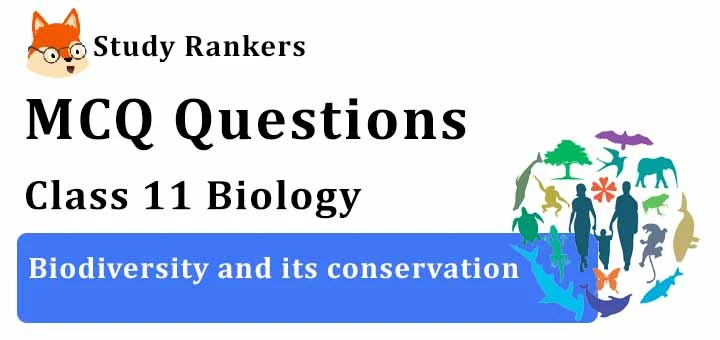MCQ Questions for Class 12 Biology: Ch 15 Biodiversity and its conservation

1. Alpha diversity will describe:
(a) diversity within biomes
(b) intra community diversity
(c) inter community diversity
(d) diversity within a species population
► (b) intra community diversity
2. Fertility of soil is measured by its ability to
(a) retain nutrients
(b) hold organic materials
(c) hold water
(d) support life
► (d) support life
3. The species of animals protected in Kaziranga sanctuary is
(a) Panthera tigris
(b) Macaca mullata
(c) Panthera leo
(d) Rhinocersos unicornis
► (d) Rhinocersos unicornis
4. American water plant that has become a troublesome water weed in India is
(a) Cyperus rotundus
(b) Eichhornia crassipes
(c) Trapa latifolia
(d) Trapa bispinosa
► (b) Eichhornia crassipes
5. If all the members of a host species die then all its unique parasites also die off, representing:
(a) biological control
(b) co-extinction
(c) conservation
(d) extinction
► (b) co-extinction
6. To preserve seeds that rapidly lose viability, can’t survive dessication and plants which are propagated vegetatively, method employed is :
(a) cryopreservation
(b) agroforestry
(c) gene sanctuary
(d) in - situ conservation
► (a) cryopreservation
7. When we compare the relationship between species richness and area for wide variety of taxa, the graph appears to be a:
(a) cubic parabola
(b) rectangular hyperbola
(c) cubic hyperbola
(d) rectangular parabola
► (b) rectangular hyperbola
8. Out of the following which one will not represent an alternative way to categories ecosystem diversity:
(a) population diversity
(b) community diversity
(c) habitat diversity
(d) landscape diversity
► (a) population diversity
9. Speciation maintains biodiversity :
(a) only at individual level
(b) only at species level
(c) only at community level
(d) both at species level and community level
► (d) both at species level and community level
10. Largest amount of fresh water is found in
(a) lakes and streams
(b) underground
(c) polar ice and glaciers
(d) rivers
► (c) polar ice and glaciers
11. How many bio-geographical regions are present in India?
(a) 3
(b) 4
(c) 10
(d) 5
► (c) 10
12. A sacred lake is
(a) Suraj kund Lake of Haryana
(b) Chilka Lake of Orissa
(c) Dal lake of Kashmir
(d) Khecheopalari Lake of Sikkim
► (d) Khecheopalari Lake of Sikkim
13. Bulk fixation of carbon through photosynthesis takes place in
(a) Tropical rain forests
(b) Tropical rain forest and crop plants
(c) Crop plants
(d) Oceans
► (d) Oceans
14. Red data Book deals with:
(a) Animals on verge of extinction
(b) Plants showing photoperiodism
(c) Endemic plant
(d) Plants that are extinct
► (a) Animals on verge of extinction
15. Which animals is the symbol of the World Wildlife Fund?
(a) Horn bill
(b) Giant panda
(c) White bear
(d) Tiger
► (b) Giant panda
16. If a species experiences a 90 percent decline over 10 years (or three generations), would be classified as:
(a) critically endangered
(b) vulnerable
(c) data deficient
(d) endangered
► (a) critically endangered
17. Keystone species include:
(a) Only tiger
(b) Only American bullfrogs
(c) Tiger, Salmon and Sea Otters
(d) Sea otters and American bullfrogs
► (c) Tiger, Salmon and Sea Otters
18. Polyps and medusae of coelenterates (fixed and free-floating stages) are examples of polymorphism related to:
(a) genetic diversity
(b) species diversity
(c) ecosystem diversity
(d) habitat diversity
► (a) genetic diversity
19. The species becomes extinct most easily by:
(a) Deforestation
(b) Heavy rains
(c) Urbanization
(d) Sliding of hills
► (a) Deforestation
20. Soil fertility is reduced by
(a) crop rotation
(b) nitrogen fixing bacteria
(c) decaying organic matter
(d) intensive agriculture
► (d) intensive agriculture
21. Biological diversity level that doesn’t exist is:
(a) gamma
(b) beta
(c) delta
(d) alpha
► (c) delta
23. Project elephant started in the year:
(a) 1990
(b) 1993
(c) 1992
(d) 1982
► (c) 1992
23. Which animal has become extinct from India?
(a) Snow Leopard
(b) Hippopotamus
(c) Wolf
(d) Cheetah
► (d) Cheetah
24. Deforestation will decrease
(a) soil erosion
(b) land slides
(c) soil fertility
(d) rainfall
► (d) rainfall
25. Renewable source of energy is
(a) Biomass
(b) Coal
(c) Petroleum
(d) Kerosene
► (a) Biomass
26. MAB stands for
(a) Man and Biology Programme
(b) Man and Biosphere Programme
(c) Mammals and Biosphere Programme
(d) Mammals and Biology Programme
► (b) Man and Biosphere Programme
27. Which animal has gone extinct in recent times in India?
(a) Panthera leo
(b) Acinonyx jubatus
(c) Antilope cervicapra
(d) Rhinoceros unicornis
► (c) Antilope cervicapra
28. Tropical Botanical garden and research institute is situated at:
(a) Tiruvananthapuram
(b) Kerala
(c) Andra Pradesh
(d) Shimla
► (a) Tiruvananthapuram
29. Sacred grooves are specially useful in
(a) Preventing soil erosion
(b) Year- round flow of water in rivers
(c) Generating environmental awareness
(d) Conserving rare and threatened species
► (d) Conserving rare and threatened species
30. Species which suffered a near-extinction from ingesting the carrion of diclofenac-treated cattle is/are:
(a) only white rumped vulture
(b) Himalayan Wolf and Bengal tiger
(c) Striped Hyena and white rumped vulture
(d) Bengal tiger and white rumped vulture
► (d) Bengal tiger and white rumped vulture
31. Which of the following can solely keep an ecosystem self-sustaining and viable?
(a) producer-decomposer food chain
(b) producer-predator food chain
(c) producer-consumer food chain
(d) consumer-decomposer food chain
► (a) producer-decomposer food chain
32. Which article of the Constitution of India specifies that, "it shall be the duty of every citizen of India to protect and improve the natural environment including forests, lakes, rivers, and wildlife and to have compassion for living creatures."
(a) Article 48
(b) Article 52-A
(c) Article 51-A
(d) None of these
► (c) Article 51-A

